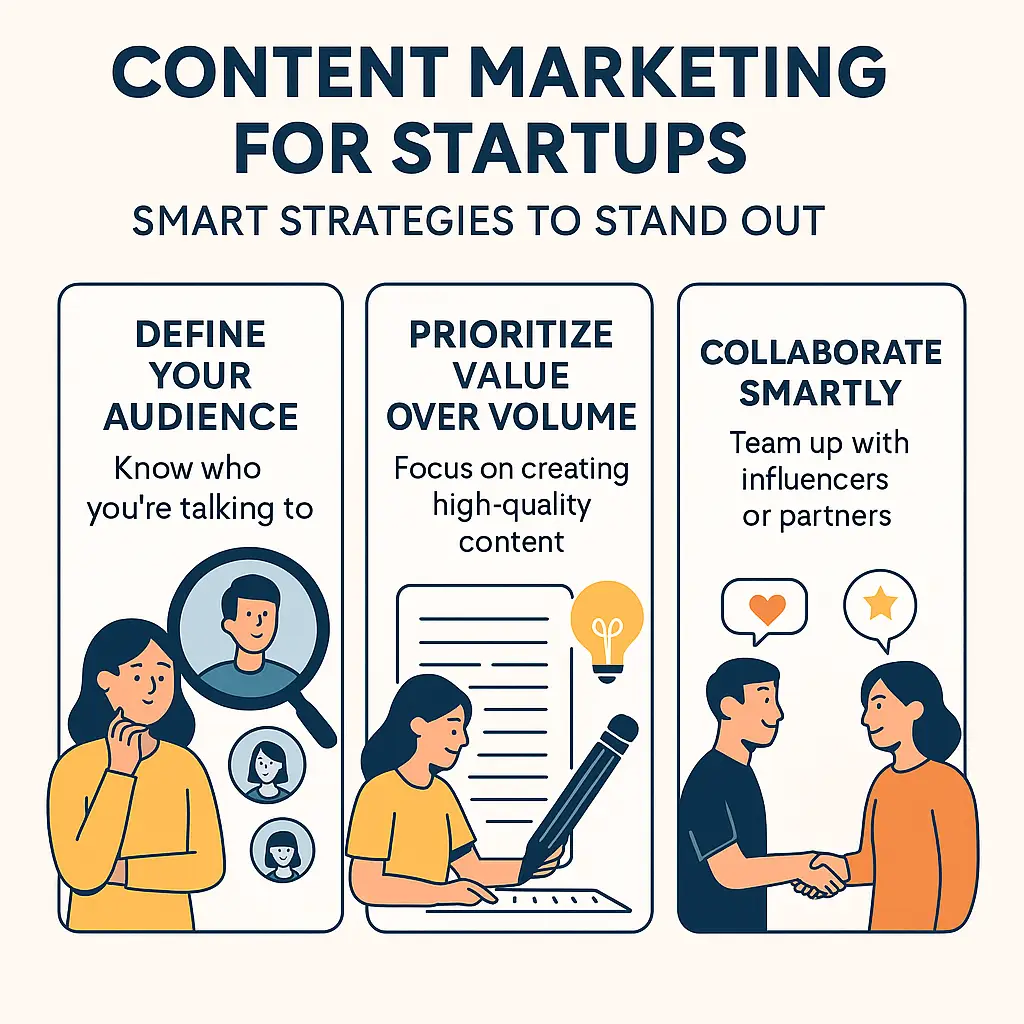In today’s digital-first world, content marketing is more than just a buzzword, it’s a powerful tool that helps startups punch above their weight. With limited budgets and brand visibility, startups can’t always outspend competitors, but they can outsmart them with content that connects, converts, and creates community.
So, how can you use content marketing to build credibility, attract the right audience, and fuel growth, without breaking the bank? Let’s break it down.
What Makes Content Marketing a Game-Changer for Startups?
Think of content marketing as the long game that pays off. It’s about sharing value before asking for anything in return. For startups, that means:
- Building trust with potential customers
- Positioning your brand as an expert
- Creating a steady flow of organic traffic
- Competing with big players, minus the big-budget ad spends
If you’re willing to play the long game, content marketing can become your strongest growth engine.
Define Your Audience First: The Foundation of Content Marketing
The first rule? Don’t try to talk to everyone.
Startups need to clearly define their audience, who they are, what they care about, and what problems they’re trying to solve. That starts with basic customer personas and market research.
Once you’ve nailed your audience, set SMART goals for your content: Do you want more traffic? More leads? More demos? Your goals will shape what you create.
5 Proven Content Marketing Strategies for Startups to Drive Growth in 2025
Here are the top startup-friendly strategies you can start applying right now.
1. Prioritize Value, Not Volume
You don’t need to publish every day. Instead, focus on high-impact content that offers real value.
- Solve a problem. Answer the questions your audience is already Googling.
- Be original. Don’t just rehash the same tips, offer unique insight, data, or examples.
- Repurpose wisely. One blog post can become a LinkedIn thread, a video script, or an email series.
2. Master SEO Basics to Boost Visibility
Good content is great. But good content that no one sees? Not so great. With search engines evolving to highlight AI-generated summaries over traditional results, your content needs to be structured for both people and machines. We unpacked this shift in our deep dive on AI Mode and SEO – it’s worth a read if visibility is your top priority.
Use SEO best practices to improve discoverability:
- Do keyword research using tools like Ubersuggest or Ahrefs
- Include keywords naturally in titles, headers, and throughout the content
- Use clear meta descriptions and alt text for any images
- Link internally to your other blogs or resources
Search engines love structure, and readers do too.
3. Use Social Media to Repurpose and Engage in 2025
Social media isn’t just about being visible—it’s about being valuable where it counts.
Startups don’t need to be on every platform. Pick one or two where your audience actually spends time. For B2B? LinkedIn. For visual-first storytelling? Instagram. For news and hot takes? X (formerly Twitter). For deeper discussions? Consider platforms like Reddit or even Slack communities.
Once you’ve chosen your channels, focus on consistency and creative repurposing.
Here’s how to turn one blog into a week’s worth of engaging content:
- Short-form video: Use Instagram Reels, TikToks, or LinkedIn video snippets to summarize key insights in under 60 seconds.
- Carousel posts: Break down your blog into bite-sized slides with bold headlines and visuals.
- Behind-the-scenes posts: Share your content creation process, team thoughts, or “why we wrote this” insights.
- Polls and AMA (Ask Me Anything) sessions: Spark interaction with your community and gather feedback or topic ideas.
- Use scheduling and AI tools: Platforms like Buffer, Later, and Canva’s Magic Studio can help batch and automate content effortlessly.
Social media isn’t just a traffic lever anymore—it’s a dialogue builder. The more human and helpful you are, the more your audience will stick around, engage, and convert.
4. Drive Conversions with Smart Email Marketing in 2025
Email still converts, and in 2025, it’s smarter than ever.
Start by building your mailing list with content upgrades your audience actually wants: think downloadable guides, free tools, or short courses. But it’s what you do after they subscribe that counts.
Instead of blasting the same message to everyone, use automation tools to create tailored email journeys based on user behavior. For example:
- Welcome series for new signups
- Cart abandonment nudges for ecommerce startups
- Lead nurturing workflows for B2B demos
- Re-engagement campaigns for inactive users
Trends to take note of in 2025:
- AI-powered personalization: Tools like Mailchimp, Brevo, or HubSpot now personalize send times, subject lines, and content blocks automatically.
- Hyper-segmentation: Move beyond just demographics—segment based on user intent, behavior, or funnel stage.
- Interactive emails: Embed polls, quizzes, or product previews that users can engage with without leaving their inbox.
- AMP emails: Enable users to RSVP, check out, or browse content inside the email.
Curious how email marketing fits into your startup’s growth strategy? Don’t miss our full guide, How to Convert Like a Pro with Smart Email Marketing — it’s packed with hands-on tips to help you boost engagement, nurture leads, and turn your mailing list into a growth channel.

Source: Inkorporated
5. Collaborate with Influencers and Partners
No audience yet? Borrow one.
If you’re still building your following, don’t go alone. Partnering with micro-influencers, niche bloggers, or respected thought leaders in your space can give your content instant visibility and credibility. You don’t need someone with a million followers, just someone with a loyal, engaged audience that overlaps with your ideal customer base.
Look for collaborators whose tone, values, and style align with your brand. Whether it’s a joint webinar, guest blog, or co-branded content, these partnerships are about relevance, not just reach, and the right fit can drive genuine interest and trust.
Common Content Marketing Challenges Startups Face (And How to Tackle Them)
Let’s be real, content marketing isn’t magic. It’s strategic, time-consuming, and at times, frustrating. But knowing the hurdles ahead of time can help you stay agile and keep moving forward.
Limited Resources? Make Every Piece Count
The challenge:
Startups usually don’t have a dedicated content team or generous budgets. That’s okay, you can still win with content.
The fix:
Start small. Focus on cornerstone content (like one strong blog post a week), and repurpose it into social media snippets, email content, or LinkedIn carousels. If hiring a writer isn’t possible, consider outsourcing one-time projects or using AI tools to build first drafts that your team can polish.
Running Low on Ideas? Try Audience-First Thinking
The challenge
Creative fatigue is real, especially when juggling other priorities. You won’t always have a groundbreaking story to tell, and that’s fine.
The fix:
Instead of brainstorming in a vacuum, go where your audience is. Use tools like AnswerThePublic, Reddit, Quora, or niche Facebook groups to discover what people are asking in your space. Turn those questions into articles, guides, or quick how-tos that genuinely help.
Pro tip: Keep an ongoing content ideas list. Every team member can contribute when inspiration strikes.
Struggling with Reach? Rethink Distribution
The challenge:
Creating amazing content is only half the battle. If no one sees it, it’s just a beautifully written secret.
The fix:
Map out a simple but intentional distribution plan. Make SEO your long game. Use email marketing to re-engage warm leads. Tap into social media with platform-specific snippets and visuals. Share your posts multiple times over a month, not just once.
Also consider: Collaborations with other startups or industry voices for cross-promotion.
Can’t Measure ROI? Look Beyond the Likes
The challenge:
It’s hard to prove value when content doesn’t instantly lead to conversions. Patience is key, but data matters.
The fix:
Set clear KPIs beyond pageviews. Use Google Analytics to track how long visitors stay, where they drop off, and which pages lead to form fills or downloads. Platforms like HubSpot and Mailchimp can help connect your content to actual lead behavior.
Final Take: Content That Compounds Over Time
Content marketing isn’t about quick wins. It’s about building trust, growing organically, and nurturing long-term relationships.
Startups that invest in thoughtful content strategies today will see compounding returns, not just in traffic or leads, but in brand reputation and customer loyalty.
Need help creating content that makes an impact? We’d love to help you craft a content plan that drives real results, from strategy and writing to visuals and distribution.

